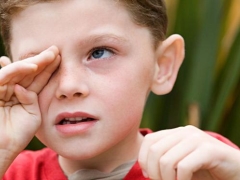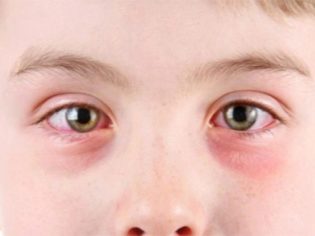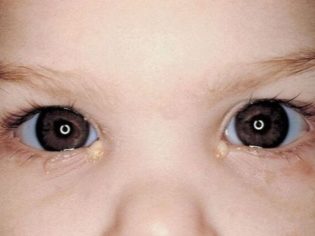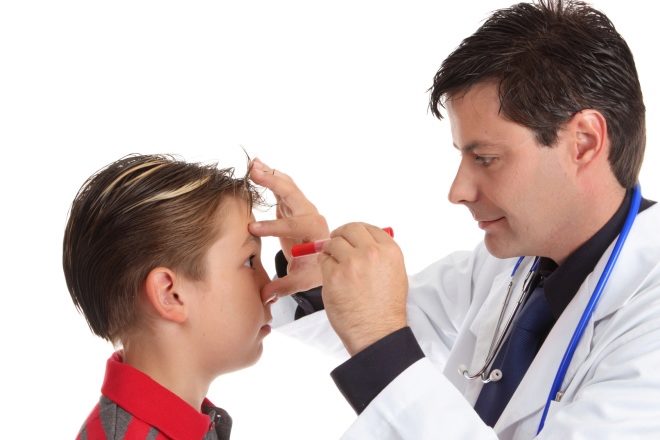Viral conjunctivitis in children
Among the various ophthalmic diseases in children, viral conjunctivitis is quite common. Any child up to ten years old can get sick with a high probability. Recognize the first manifestations of conjunctivitis can every mother, knowing the main symptoms of the disease. The earlier the disease is detected, the better and more favorable the prognosis and treatment.
Common causes
Inflammation of the mucous membrane of the eye or conjunctiva is called conjunctivitis. Most often in children of the first three years of life an acute process occurs. In this case, the symptoms appear very quickly. The first manifestations occur within a couple of hours after the pathogen enters the child’s body.
To date, scientists have more than 20 different types of viruses that can cause inflammation of the mucous membrane of the eyes. The most common variant is adenoviral conjunctivitis. In this case, the cause of the disease are adenoviruses.
In addition to inflammation on the mucous membrane of the eyes, they can also cause severe runny nose and lead to respiratory failure. The disease is usually quite difficult with severe symptoms of intoxication and fever.
More rare causes of viral eye diseases include herpes variants. The human herpes virus damages many mucous membranes in the body, including the eyes. The disease, as a rule, is more common in weakened and only recovered children. Quite often cases of viral conjunctivitis in babies with congenital or acquired immunodeficiency are recorded.
The familiar flu virus can also cause inflammation on the mucous membrane of the eyes. Such a manifestation of the disease occurs infrequently. This option is most difficult for newborn babies and children of the first year of life. The treatment requires the use of specific drugs that have a detrimental effect on the virus.
Dr. Komarovsky believes that the timely appointment of antiviral drugs in the form of eye drops for the treatment of influenza virus conjunctivitis helps to significantly speed up the recovery of the baby.
Quite rarely, pediatricians report infection with viral conjunctivitis in utero. In this case, the child, while still in the womb of the mother, may become infected. Such cases are most common in congenital rubella. Treat the disease immediately after birth.
Main symptoms and signs
Confusing conjunctivitis from another eye disease is quite difficult. This disease occurs with severe clinical symptoms.
The most common manifestations of viral conjunctivitis are:
- Severe tearing. Discharge is usually light. However, when attaching a secondary bacterial infections, discharge may be bloody or purple. In the daytime, lacrimation increases significantly. In the evening or at night, the baby feels much better.
- Red eyes. Strong redness is characteristic of both eyes at the same time. Blood vessels begin to protrude strongly above the surface of the inflamed conjunctiva. Hit of sunshine promotes strengthening of a redness and dacryagogue.
- Strong photophobia. Being in a bright room for a baby with acute conjunctivitis brings pronounced discomfort and soreness.Getting on the inflamed conjunctiva, the sun's rays cause its additional traumatization and increase the pain syndrome. Kids try to blink more often, prefer to sleep more or lie with their eyes closed. By evening, this symptom is reduced.
- Suppuration. In viral conjunctivitis is not always the case. As a rule, this symptom appears when a secondary bacterial infection is attached. With a simple course of the disease, the release of pus is not characteristic.
- Swelling of the eyelids. Severe inflammation leads to swelling of all mucous membranes of the eye. Eyelids become condensed and swollen. Kids have a sullen look. Overhanging of the swollen upper eyelids can lead to visual impairment and even double vision when examining various subjects.
- Increased body temperature. Viral diseases are characterized by rather bright symptoms of intoxication. In an uncomplicated version of the disease, the body temperature rises to 37-37.5. In more severe cases - up to 38-39 degrees. With a dangerous course of the disease, treatment is already required in a children's hospital.
- Nasal congestion, respiratory failure, in some cases cough. This combination of symptoms is most common in adenoviral diseases. Adenoviruses, multiplying and damaging the mucous membranes, very often cause a whole range of different manifestations.
All symptoms of viral conjunctivitis appear after the incubation period. This time from the moment of the first contact of the pathogen into the body until the onset of the primary manifestations of the disease. For viral inflammatory diseases of the eye, the incubation period ranges from 4-6 hours to one day.
Getting and spreading in the body, viruses quickly damage the mucous membranes. Having a toxic effect on cells, they cause severe inflammation, which leads to the appearance of classical manifestations of the disease. With timely diagnosis and treatment, viral conjunctivitis lasts 5-7 days. In more severe cases or when joining a secondary bacterial infection, the disease may last for a couple of weeks.
Diagnosis of viral conjunctivitis
Appointment of the correct treatment is impossible without prior correct diagnosis. Very vivid classic manifestations of viral conjunctivitis allow parents and doctors to quickly suspect eye inflammation. However, it is not easy to establish a diagnosis in all cases. Sometimes additional examinations and tests are required to determine the cause of the disease.
Most often viral conjunctivitis is confused with bacterial. In this case, the usual blood test comes to the rescue. Such a simple laboratory test allows the doctor to confidently say what exactly the pathogen was responsible for the disease. Was it a bacterium or a virus. Also, using a blood test, a pediatrician can determine the severity of the disease.
In the earliest stages of the disease, an excellent way to diagnose the virus that caused the disease will be to conduct bacposeva.. The material for such studies is the lacrimal discharge. This test allows you to determine the type of virus that caused the disease. Conducting such a survey is most informative only in the first couple of days since the onset of the disease.
Treatment
Every year for the treatment of viral conjunctivitis, the list of drugs is growing and expanding. According to reviews of moms, modern drugs for the treatment of inflammation of the conjunctiva of the eyes have better tolerance in children and do not cause numerous adverse reactions.
Treatment of viral conjunctivitis is prescribed only by a pediatric ophthalmologist. When the baby first signs of illness - try to quickly show it to the doctor. The pediatrician will be able to determine the nature of the disease and prescribe all necessary treatment.
Mild viral conjunctivitis can be treated in the course of the disease. home conditions. The complex of therapy, as a rule, includes the following therapeutic procedures:
- Mandatory regular eye rinsing. For this purpose, disinfectant solutions or medicinal herbs are used. Perfect chamomile decoction. Treat eyes should be at least 3-4 times a day. Remove detachable need from the inner corner to the nose. For each eye, different cotton pads are used.
- The appointment of therapeutic antiviral eye drops. Appointed from the first hours of the disease to 5-7 days. Frequency, dosage and duration selects the attending physician. When attaching a secondary bacterial infection, antibacterial eye drops or ointments are also required.
- Sufficient drinking mode. To eliminate the symptoms of intoxication, the baby needs to drink plenty of fluids. Per day usually from 1.5 liters. As drinks, the child can offer warm boiled water or berry compotes, as well as a variety of fruit drinks. Such drinks compensate for the lack of fluid in the children's body and help to quickly remove residual viral toxins.
- Compliance with the regime of the day. In the acute period of the disease, the baby must sleep during the day. During rest, the damaged mucous membrane of the eye is restored and heals. A child must sleep at least 10 hours a day. Try to curtain your room with dark curtains. This will help your baby fall asleep sooner.
- Walking in the summer for the entire acute period of the disease is better to limit! Solar activity contributes to the additional trauma of the damaged eye and increases the discomfort and pain. When the inflammation subsides, you can go out. Be sure not to forget about the headdress for a child! It is better to choose products from the breathing material with wide fields.
- The inclusion in the diet of protein foods. During any viral infection, a sufficient supply of all essential nutrients in the body is required. For a good immune system, you need an optimal amount of protein. Try to include a bird or fish in the children's menu, as well as beef. Do not forget about dairy products. They quickly saturate and improve the work of immunity.
- Bathing in the early days of the disease should be limited. If the baby has a fever, then you should not bathe the baby. Transfer water procedures for several days. You can wipe your baby with a clean cloth or towel dipped in warm water. In the first days of the disease in the bath for bathing is better to add decoctions of herbs that have a bactericidal effect. Perfect decoction chamomile or calendula.
Treatment of viral conjunctivitis requires a range of different therapeutic measures. From the first hours of illness, doctors prescribe various eye drops:
-
Ophthalmoferon. This drug helps to fight the main manifestations of viral inflammatory eye diseases. Perfectly eliminates redness and tearing, and also significantly reduces itching. Usually assigned 1-2 drops in each eye up to 5-6 times a day.
-
Aktipol. It is used to accelerate the healing of damaged conjunctiva. Helps in restoring the mucous membrane of the eye. Usually the drug is prescribed for 5-7 days, 2 drops. The frequency of admission is chosen by the attending physician.
-
Oftan I am coming. It is prescribed for the treatment of inflammatory eye diseases for children over two years old. Discharged for a period of 5-6 days. After all the adverse symptoms have disappeared, it is allowed to use the drug for another five days. This scheme helps prevent the transition of the disease to the chronic form.
Parents should remember that before instillation of therapeutic eye drops, hands must be washed! It is better to use antibacterial soap for this. This will help prevent additional bacterial infection in the eye.
Timely treatment of viral conjunctivitis helps to cope with the adverse symptoms of the disease. With adequate therapy, chronization of the process, as a rule, does not occur. After a week, babies return to their normal lifestyle.
Causes of conjunctivitis will tell Dr. Komarovsky in the video below.



























